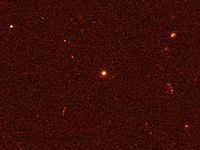GRB 110328A
| GRB 110328A | |
|---|---|
 GRB 110328A imaged by Hubble Space Telescope. | |
| Detection | |
| Detection time | 28 March 2011 |
| Detected by | Swift |
| Duration | more than 7 days |
| Position | |
| Right ascension | 16 44 49.97 |
| Declination | +57° 34′ 59.7″ |
| Redshift | 0.35 |
| Distance | 3.8 billion light-years (920 Mpc) |
| Constellation | Draco |
| Energetics | |
| Total energy output | 5×10 ergs |
| Other designations | |
| Swift J164449.3+573451 | |
| See also: Gamma-ray burst, Category:Gamma-ray bursts | |
GRB 110328A is the longest lasting gamma-ray burst (GRB) detected by the Swift Gamma-Ray Burst Mission on March 28, 2011. The explosion occurred in the center of small galaxy in the Draco constellation, about 3.8 billion (3.8×10) years ago.
Studied by dozens of telescopes, it's one of the most puzzling cosmic blasts of high-energy radiation ever observed when it comes to brightness, variability and durability. It probably came when a star wandered too close to the central black hole in the galaxy, and was gravitationally torn apart and swallowed by it. The beam of radiation appears to be pointed directly toward Earth.
See also
References
Coordinates: ![]() 16 44 49.97, +57° 34′ 59.7″
16 44 49.97, +57° 34′ 59.7″
Retrieved from : http://en.wikipedia.org/wiki/GRB_110328A
No comments:
Post a Comment